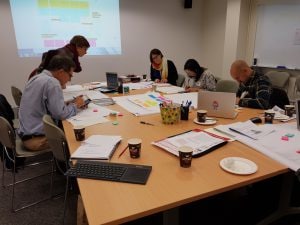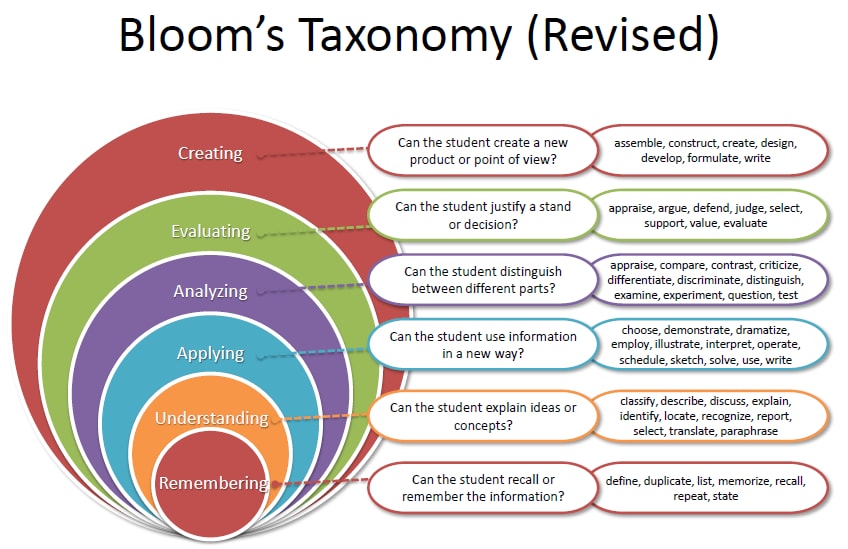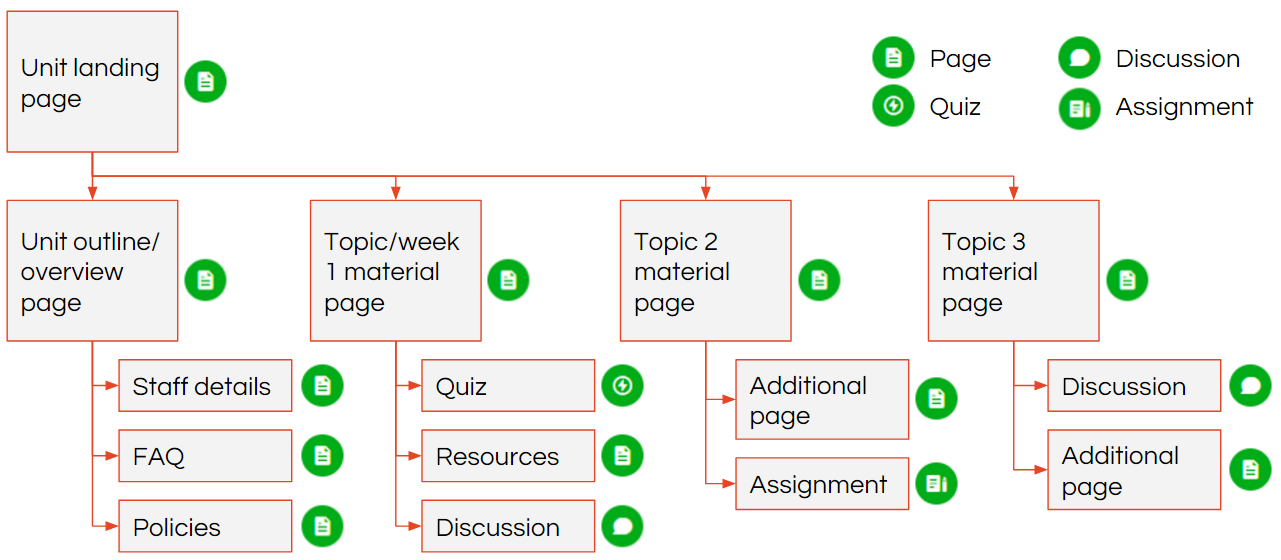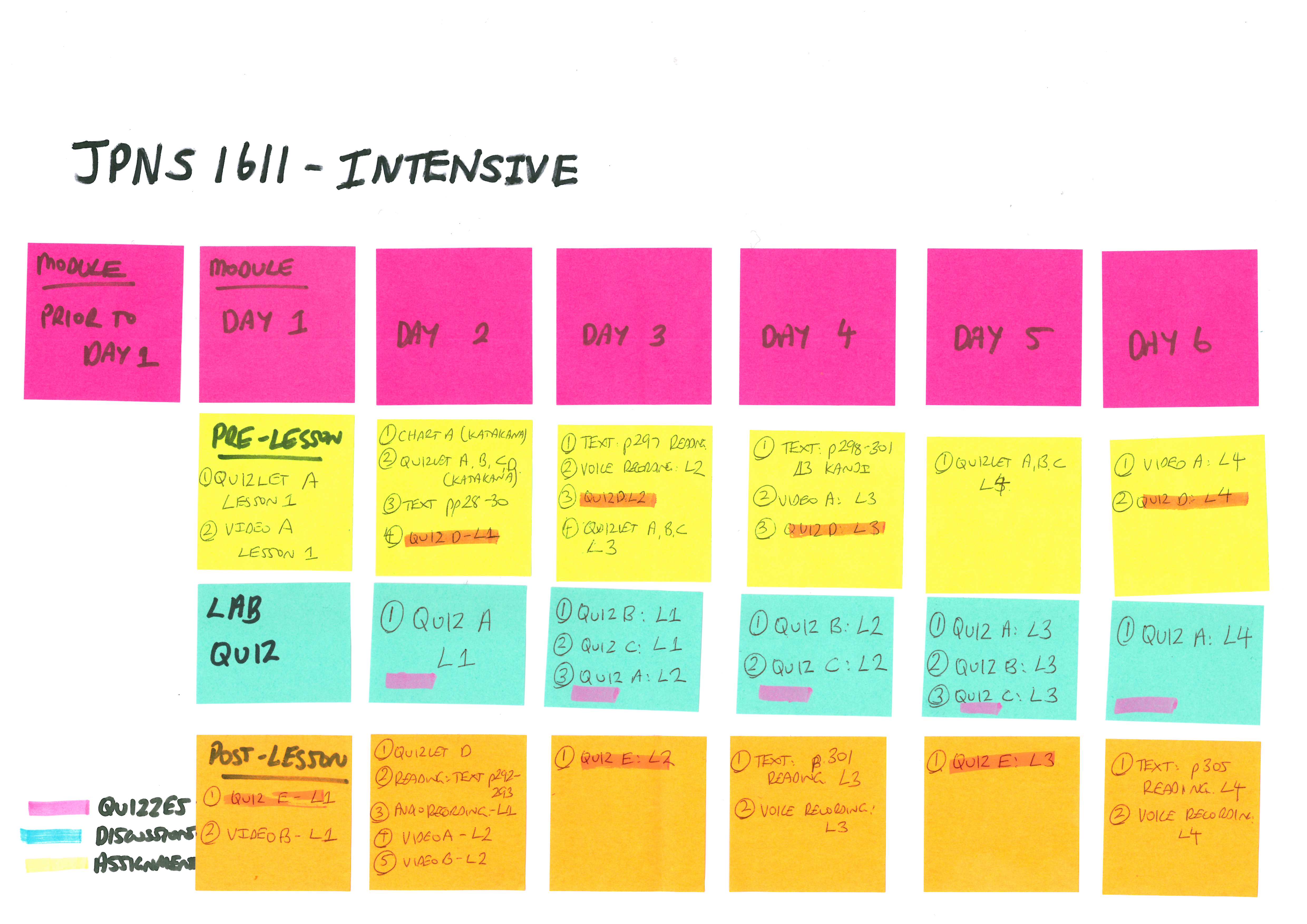Stage 1 – Visualising your UoS design
Jessica Frawley’s recent article in Teaching@Sydney, ‘(Re)designing Your Unit of Study – Learning Outcomes and Constructive Alignment’, spoke of the importance of alignment, and gave us quick tips on how we can achieve it. This same principle was our frame of reference in the recent FASS Storyboarding workshops for our OLE pioneers and subsequently for our FASS First Year Coordinators Program participants. Demonstrating alignment in our Units of Study was our objective.

Charged with large pieces of butcher paper, multi-coloured post-it notes, markers and stickers, we all bravely ventured into the colourful unknown.
As opposed to our ‘Do-Re-Mi’ renditions, we started not at the beginning, but at the end and we worked backwards, gradually adding in all of the pieces that will complete our ‘puzzle’, otherwise known as our Unit of Study (UoS). The goal of course, is achievement of the Learning Outcomes (L.O.) and ultimately the Graduate Qualities.
In constructing our L.O.s, we began by considering carefully the verb that follows the statement: “On successful completion of this course students should be able to …”. We recognised that the L.O.s should use measurable verbs of student activity, which we based on the 6 levels of cognitive learning (Bloom’s revised Taxonomy). Initial L.O.s may focus on the lower order thinking skills (remembering / understanding), however ideally, we should aim to also achieve some higher order thinking (applying / analysing / evaluating / creating) as well. We addressed which verbs to use and what type of activities each might suggest. And so, the challenge had begun!

Next, we looked at both the formative and summative assessment tasks for the whole unit. We addressed the ‘whats’, ‘whens’, ‘hows’ and ‘whys’ regarding each task; ‘What will the students do?’; ‘When and how will they do it?’; and perhaps most importantly, ‘WHY are they doing it?” The final question of course is pivotal in motivating the students to really engage with the task. We also noted the importance of having assessment commence early in semester to support any required behavioural changes, whilst also ensuring enough time in between each task to provide adequate scaffolding and feed forward opportunities.
Finally, we considered the same four questions in relation to each ‘Content’ item to be shared with the students, i.e. readings, videos, URL links etc. and ‘Activities’, i.e. engagement with this content. We discussed the varieties of tools and resources that could be used to achieve both, in particular in line with Strategy 5 – Initiative 1, to make the learning a more interactive and student-centred experience.
Each level in the Storyboard was represented by a different coloured post-it note: Content, Activities, Assessment Tasks and L.O.s. We numbered the L.O.s from 1 – x and used these numbers to confirm which activities and assessment tasks addressed each L.O. It was beneficial for our participants to consider whether the students are, in fact, achieving each of the L.O.s through the activities and assessment design. As it’s almost guaranteed that our students have not made this connection either, we discussed the importance of including within the instructions of each assessment task which L.O.s would be achieved.
Then, the finale was to utilise coloured markers to illustrate the feedback and feed forward opportunities from ‘student activity’ to ‘assessment task’ and between ‘assessment tasks’.
Phew! We had made it through to the other side, and we all felt better for the experience, with many pretty colours on our butcher’s paper to show for our hard work! HOWEVER, just as our pioneers breathed a sigh of relief AND while they were still on the euphoric high from their achievements, I informed them of the all-important Stage 2: “Translating our UoS Storyboards into Canvas!”
Stage 2 – Visualising your Canvas LMS site
As we transition from Blackboard to Canvas, each UoS Coordinator needs to have a clear vision of how their Canvas site should be designed to best support their UoS. Experience tells us that reliance on verbal explanation alone is inefficient.
Creating a visualisation on paper showing how the ‘story’ comes together, facilitates more efficient discussion between the UoS Coordinator and support staff, making this time more productive. Everyone concerned was able to see the goal and how the various components fit together to make the ‘whole’.
Despite being armed with our UoS storyboards from Stage 1, translating this into a clear Canvas structure was challenging.

We started with basic structure from the ‘Introduction to Canvas’ sessions, as a guide.
We chose a different colour for each Canvas element, i.e. ‘modules’ and ‘pages’ (as illustrated above), or by more specific ‘content’, ‘activities’, ‘discussions’, ‘quizzes’ etc. within the modules, referring to a number of exemplars. One exemplar of a UoS that is 70% f2f and 30% online and is taught in intensive mode, was to have each module (day) divided into ‘pre-lesson’ and ‘post-lesson’ activities & material.

Next, we used highlighters to clearly identify which components were ‘discussions’, ‘quizzes’ and ‘assignments’. The clearer the ‘story’ is, the better the final result.
Drawing a picture of how your UoS Canvas site should look is much more than a conversation starter. It provides the framework to create a robust and well-structured, re-designed Unit, that should carry you through numerous future iterations.





